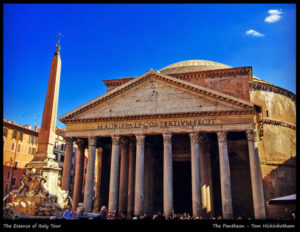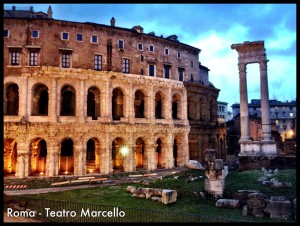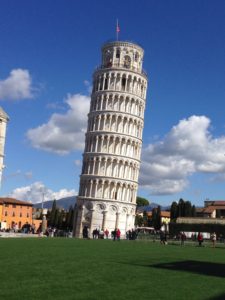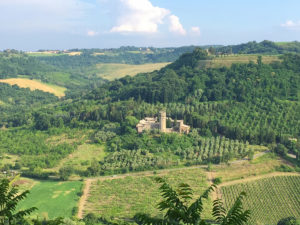by Dawnielle Jacobson | Jul 12, 2019 | Destinations
Rome: Baroque City Center
Explore some of the sites in Rome’s Baroque city center.
 Piazza Venezia
Piazza Venezia
This busy piazza in the center of Rome is lined with several palaces, the most important being the Palazzo Venezia. It was constructed by Pope Paul II (1464-71) and is one of the first buildings in Rome constructed in the Renaissance style. The huge white building to the south is the Monument to Vittorio Emanuele II, the first king to unite Italy. It dates only from 1885 and houses the Tomb of the Unknown Solider as well as a fantastic view for those who climb the steps.
The Trevi Fountain
This famous fountain was commissioned from Nicola Salvi in 1762 by Pope Clement XIII. It is a colossal masterpiece dating from the Baroque era. The central figure, the Ocean, rides a chariot drawn by two seahorses and two tritons. It is a famous gathering spot for tourists since the 1954 film “Three Coins in the Fountain” which was filmed in Italy and ran in the United States. However, local Roman legend has it that throwing one coin in the fountain will bring good luck and assure a return trip to Rome. It seems that the “three coin” theme arises from the movie’s title. The movie details the romantic adventures of three different young women falling in love with three different men while on holiday in Italy. It is said that over €3,000 a day is collected from the fountain and used to supply the local food bank.
 Pantheon
Pantheon
A perfectly preserved ancient building founded by Agrippa in 27 BC. It was later rebuilt by Hadrian (117-25) as a temple to all gods. The 7th century saw it change from a pagan temple of worship to a Christian church. The portico is supported by 16 solid granite columns (all original except for the three on the left). The humongous doors are the originals and still open and close on their original hinges. Most important is the DOME, equal in width and height. This was a grand architectural achievement for its time… in fact it wasn’t until the age of the Renaissance that another such dome was constructed for the cathedral in Florence. The interior contains the tombs of some kings and, most notably, that of the artist Raphael, on the left from the entrance.
Piazza Navona
A lively square filled with artists, musicians, cafés and street performers. It sits on the site of the former Roman-period Domitian stadium, a chariot and horse racing track. In the center of the oval-shaped square sits Bernini’s Fountain of the Four Rivers, a Baroque masterpiece completed in 1851. Newly cleaned, its statues represent four rivers symbolizing the four corners of the earth… the Danube, the Ganges, Rio de la Plata and the Nile.
To read about sites in Ancient Rome, click here.
To read about sites in Vatican City, click here.
Your Adventure Starts Here!


by Dawnielle Jacobson | Jul 12, 2019 | Destinations
Ancient Rome
Read about some of David’s favorite sites dating back to ancient Rome.
 The Colosseum
The Colosseum
This massive arena is the first image that comes to mind when I think of Rome. Constructed by the Emperor Vespasian (the first of several “Flavian” emperors) it was inaugurated in AD 80 as the Flavian Amphitheatre. The Romans were always seeking ways to take a Greek idea and put a new Roman twist on it. The Flavian Amphitheatre is no exception. In essence, the Romans took the plans for a Classical Greek theatre and built two of them end to end, coming up with the design for a huge freestanding “amphi” theatre.
Nero, Emperor Vespasian’s predecessor, had constructed a lavish palace just over the hill, behind the modern-day metro station. The site where the Colosseum sits today was once a large man-made lake surrounded by porticos, balconies and grand walkways. This palace complex, known as the Domus Aurea (Golden House), contained a colossal 33-meter-tall (100 feet) bronze statue of the Emperor Nero. After the Flavian Amphitheatre was constructed, Vespasian had Nero’s colossal statue placed out in front of his new colossal amphitheatre. The combination of the colossal statue of Nero and the colossal amphitheatre seemed to stick and the amphitheatre took on the nickname of the Colossal-seum, or Colosseum. Nero’s statue has perished, but you can see the site where it once stood on the grassy area between the Colosseum and the wrought iron fence flanking the forum area.
The Romans were known as great builders and pioneered many construction techniques still in use today. One such idea was that of the “rounded arch” and concrete. Essentially, the Romans would construct a shell of bricks and mortar and then pour concrete in the void making for a super strong and sturdy structure. This concrete-filled shell was then covered with gleaming white travertine marble for a finishing touch of grandeur. Once inside the Colosseum be sure to notice the many examples of this shell and concrete construction method.
Notice the exterior of the Colosseum; see all those potholes in the walls? The huge stones flanking the exterior were originally held together with iron pegs, buried into the stone. Then, as mentioned before, the whole thing was covered in travertine marble. The Colosseum became a relic after the fall of Rome and its ready-cut stones were cannibalized for easy building material in the Middle Ages and Renaissance period. Later, when iron was at a shortage, the Colosseum’s iron pegs were chiseled out to make weapons for war, as well as hinges, railing, and the like.
Look again at the exterior; do you see a resemblance to our modern-day soccer and football stadiums? In Roman times, the citizens attending an event at the amphitheatre had a ticket noting their seating assignment and which doorway to enter to get to their seats. Now look above the rounded arched “doorways” on the ground level and you’ll find “Roman numerals” etched into the marble noting the doorway’s number. Just like our stadiums today, the wide walkways and stairs were designed to get people into and out of the amphitheatre very quickly. Inside, along the walkways, were a multitude of kiosks in which vendors would sell official team merchandise, bowls of spaghetti, pizza and even Bud Light.
Still outside, notice the upper levels of the Colosseum. It’s not Roman at all… it’s all Greek: Corinthian columns on the top level, Ionic on the middle and Doric on the ground floor. Originally, each arch on the top levels contained a copy of Greek statues further contributing to the artistic beauty of the Colosseum.
Only a third of the original Colosseum still stands today. Some of it was destroyed in earthquakes but most was deconstructed after the fall of Rome and used as stonework for newer buildings.
Once inside the Colosseum it may be difficult to imagine just how the exposed skeleton/foundation which remains fit in with the colossal arena of Roman times. I suggest going directly to the arena/ground level as soon as you enter the ticket gate. Exiting from the tunnel into the arena is much like doing the same thing in our modern stadiums. The difference here is that you are looking at the tunneling and foundations which once supported the floor of the playing field. These skeletal pillars and passageways were once covered with wooden planks on which sand was spread to make the playing field. Arena in Latin means sand, thus the origin of our modern-day term for an oval-shaped stadium. The Colosseum’s arena was 86 by 50 meters, slightly smaller than our present-day football field. With some imagination, you can visualize the rings of seating circling the arena. Notice the buttresses and supports for the tunnels leading to the second level. Even higher up, you can still see the remains of dual stairs leading up to the cheap seats on level three. At the very top, wooden beams stuck out of the stone walls to support huge canvas tarps designed to be drawn to shade the spectators from the mid-day sun.
The Colosseum was constructed for the enjoyment and entertainment of the citizens of Rome. Admission was always free and events were often sponsored by politicians. The Colosseum opened in AD 80 with a 100-day festival of events in which 2,000 men and 9,000 animals were killed in one sort of competition or the other.
The Arch of Constantine
Exiting the Colosseum, work your way around to the right and find this massive triumphal arch known as the Arch of Constantine. It was erected here in 315 to commemorate Emperor Constantine’s victory over Maxentius in the mighty battle of Ponte Milvio (see description on page 6) and the subsequent proclamation “legalizing” Christianity. If you are a Christian, it is a very important date! Three centuries after Christ began spreading the Gospel to a lowly group of twelve disciples, his message had spread to the “utmost” parts of the world using the Roman Empire as its broadcast beacon. Higher up on the arch are some scenes carved to depict the epic battle in 313. Don’t dwell too much on the lower panels, as they have no meaning or relation to Constantine. It seems that by the time the 4th century rolled around artists were beginning to pillage older monuments to decorate the new ones.
 The Roman Forum
The Roman Forum
With the Arch of Constantine to your back, walk up the street (via San Gregorio) about 200 meters and find the entrance gate/ticket booth for the Forum and Palatine Hill. (By the way, this is a good location to purchase your entry ticket for the Colosseum, no long lines and you can walk right in to the Colosseum without the wait). The forum was the political, religious and commercial center of Rome. Citizens would mingle here on a daily basis to catch up on the gossip, purchase food, worship their gods, elect political leaders, and generally participate in Roman life.
From the entrance gate, wander around the right side of the Palatine Hill, making your way past present-day excavations to another triumphal arch dedicated to Titus. The rocky road leading from the Colosseum, through the arch and into the forum valley, is known as the via Sacra. This was the “Main Street” of Rome stretching from here to the distant Arch of Septimius Severus at the foot of Capitoline Hill (800 meters in front of you).
The Fall of Rome
Basically, Rome could not patrol its borders and invaders from the North attacked the weakened city. The year 476 marks the date when the last emperor pulled the plug and left Rome in the dark. All of Europe wasted away for a thousand years in the Dark Ages, a time of weak government, poverty and ignorance. HOWEVER, Rome lived on in the Church! The term “Emperor” now translates to “Pope,” senators became cardinals, territorial governors became bishops, orators became priests and basilicas became churches.
To read about sites in Vatican City, click here.
To read about sites in Rome’s Baroque city center, click here.
Your Adventure Starts Here!


by Dawnielle Jacobson | Jun 14, 2019 | news
 Our website says: “We believe you can do, see and experience more on a group tour than if you tried to pull it all together yourself. Think about the time, money, stress and effort you’d invest in pulling off a two-week tour to Europe. Then consider that we do it all the time and have had years of practice to refine our skills. In the end, I believe you’ll find that a tour with me will cost about the same as if you planned it yourself.”
Our website says: “We believe you can do, see and experience more on a group tour than if you tried to pull it all together yourself. Think about the time, money, stress and effort you’d invest in pulling off a two-week tour to Europe. Then consider that we do it all the time and have had years of practice to refine our skills. In the end, I believe you’ll find that a tour with me will cost about the same as if you planned it yourself.”
So, we decided to put that claim to the test! Here is a breakdown of the Best of Italy tour, a 15-day tour that costs $4589, or $305/day.
Hotel:
- The cost of stays for 14 nights in centrally located hotels with private en-suite bathrooms and breakfast included.
- Total: $2360
Dinner:
- This tour covers 7 dinners, at $40-$50 per dinner (some include wine)
- Total: $315
Tips and gratuities:
- On David’s tours, all tips and gratuities to guides, drivers, restaurant and hotel staff are included. If you were traveling on your own and renting a car, you wouldn’t have to pay a tour guide or driver, but you would still pay local guides, restaurant and hotel staff. That would be $1-2 per local guide (approximately $10 for this tour). The tip is generally included in your restaurant bill. As for hotel staff, it depends on who provides service (porter, doorman, concierge, housekeeping, etc.)
- Total: $30
Tours and admissions:
- This tour includes a guided tour of Colosseum and Forum; a guided tour of the Vatican, Sistine Chapel and St. Peter’s Basilica; walking and transportation passes in the Cinque Terre; a guided wine tasting in Volterra; a guided tour of the Galleria Accademia; entrance to the Basilica San Marco; and a two-day Vaporetto water bus pass in Venice
- Total: $370
- It also includes 4 walking/orientation tours provided by your Exploring Europe guide. If you were to do a similar tour on your own, it would be approximately 10 euros to join a group tour or 30+ euros for a private tour. So, we’ll say four tours at 10 euros.
- Total: $45
Transportation:
- Renting a car for 15 days would cost $400-$600, depending on whether you can (or want to) drive a manual or prefer an automatic. You’ll also need an international driver’s license ($20 + $12 for passport photos). Parking is 20 euros per night (~$315). If you want to drive to any destination within a city, plan for an additional 3-4 euros each time you park.
- Total: $950
Travel guides:
- David’s tours provide printed tour handouts detailing each day’s historical and cultural experiences, so there’s no need to buy a travel guidebook and lug it around.
- Total: $20
That comes to a grand total of $4090.
This means that for $500, or just $33/day, you can take this same tour stress-free.
No need to search for hotels, check the reviews, verify their availability and book online. You won’t have to worry about finding a good restaurant, deciphering the menu or pondering whether to leave a tip. You can forget about wondering whether you need a reservation to the sights you want to see or making sure they’re open. Say goodbye to searching for local guides, checking Trip Advisor reviews, worrying about their availability or planning your schedule around their tour times. No need to panic at the thought of driving on unfamiliar roads lined with foreign street signs, relying on your phone’s GPS.
If you’re ready to sit back, relax and let David show you around Europe, head over to our website to sign up for The Best of Italy tour.
Your Adventure Starts Here!


by Dawnielle Jacobson | Jun 1, 2019 | news

We are offering discounts on our most popular Italy tours. See our tour comparison chart here and read the descriptions below to find out which tour is best for you. Then head over to our website to sign up today.
Best of Italy: This tour has it all, with an ideal mix of major tourist attractions and off-the-beaten-path destinations. Visit big cities (Rome, Florence, Venice and Milan), enjoy the countryside around Tuscany and Lake Como and take a dip in the Mediterranean in the Cinque Terre.
- Choose this tour if you’ve got the time and money to experience the best Italy has to offer in a single trip.
- Number of days: 15
- Cost per day: $305
Take $500 off the original price when you sign up for one of our upcoming 2019 tours here.
Essence of Italy: This tour covers the core sites of the Best of Italy tour in as much detail (Rome, Florence, Tuscany and the Cinque Terre), but doesn’t go to Venice, Milan or Lake Como.
- Choose this tour if you’re looking for a good introduction to Italy but your time and budget are tight.
- Number of days: 10
- Cost per day: $339
Take $500 off the original price when you sign up for one of our upcoming 2019 tours here.
Tuscany Villa Vacation: On this tour, you’ll spend seven relaxing nights at a Tuscan villa, with plenty of time to soak in the local culture and take day trips to nearby towns and vineyards.
- Choose this tour if you’re looking for a more in-depth experience at a relaxing pace.
- Number of days: 10
- Cost per day: $350
Take $200 off the original price when you sign up for one of our upcoming 2020 tours here.
Your Adventure Starts Here!


by Dawnielle Jacobson | Apr 23, 2019 | news
Notre Dame
On Monday evening, a major fire erupted in the attic of Notre Dame. It blazed for 10 hours, fueled by the Cathedral’s wooden frame. Tourists the world over have shared their memories of visiting Notre Dame and lamented the damage to this jewel at the heart of Paris. But the 800-year-old cathedral still stands, and there is much to be hopeful and thankful for. To find out more about the history of Notre Dame, Monday’s tragedy and the future of this iconic monument, read our article here.
Click here to watch David’s YouTube video where he remembers his many visits to Notre Dame.
We hope that this tragic event will not deter you from experiencing all the beauty that France has to offer. Consider joining us this July on our London and Paris tour or the Best of France tour.
Your Adventure Starts Here!

 Piazza Venezia
Piazza Venezia Pantheon
Pantheon










